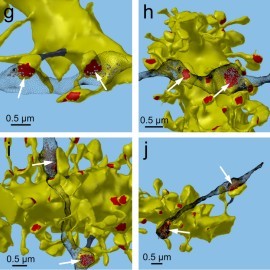1 petabyte of information is placed in the brain
 The amount of memory in the human brain was incredibly large. This topic was explored by American neurologists: authors of the scientific work Terry Sejnowski from the Institute of Biological Research Salk and Kristen Harris from the University of Texas at Austin, with colleagues. Their article is published in the eLife magazine.
The amount of memory in the human brain was incredibly large. This topic was explored by American neurologists: authors of the scientific work Terry Sejnowski from the Institute of Biological Research Salk and Kristen Harris from the University of Texas at Austin, with colleagues. Their article is published in the eLife magazine. Scientists have studied how the hippocampal neurons function, with low energy consumption they show high performance. It turned out that the capacity of the brain can be ten times more than previously thought. “This is a real bomb in neurology,” says Seinowski. “Our measurements of the amount of memory in the brain increase the conservative estimate by 10 times to at least petabytes, to about the amount of all information on the Internet.”
Seinowski, obviously, means only textual information. But even in this case, such an assessment is very impressive.
In their work, the researchers constructed a 3D model of rat hippocampal tissue based on evidence. And something strange was discovered in this model. Synapses - connections between neurons - were duplicated in 10% of cases. That is, there were not single, but paired synapses.
To measure the difference between these duplicated synapses, Seinovsky’s team reconstructed the connectivity, shapes, and volumes of rat brain matter at the nanomolecular level using modern microscopes and computational algorithms.
“We were amazed when we found that the difference in the size of the synapses from the pairs was very small, only about 8%,” says Tom Bartol, one of the scientists. - No one thought that the difference would be so small. This is such a trick by nature. "
The discovery that the difference in the size of synapses can be as little as 8% means the possibility of the existence of 26 categories of sizes of synapses (by the strength of synaptic communication), and not just a few, as previously thought. This significantly increases the "capacity" of the system, which means a significant increase in the potential amount of stored information (approximately 4.7 bits per synapse). The results of the study are shown in the video.
How synapses work
“Roughly speaking, here is an order of magnitude higher accuracy than anyone could have imagined,” explains Seinowski. - The consequences of this discovery can be serious. Under the visible chaos and disorder of the brain, there is a high accuracy and neat order that was previously hidden from us. ”
Scientists' calculations show that synapses change their size and properties, depending on the transmitted signal. Approximately 1,500 transmissions of the neuropulse cause changes in small synapses (takes about 20 minutes), while a couple of hundred transmissions (1-2 minutes) change large synapses.
In other words, every 2-20 minutes, the synapses in the brain change size, adjusting to the transmitted signal.
The discoveries made in the work of synapses can also be used in computer science, in the development of ultra-precise and energy-efficient systems using deep learning techniques and neural networks. “This brain trick will definitely help design better computers,” Seinowski said. “Using probabilistic transmission turned out to be no less accurate and much more energy efficient both in computers and in the brain.”
